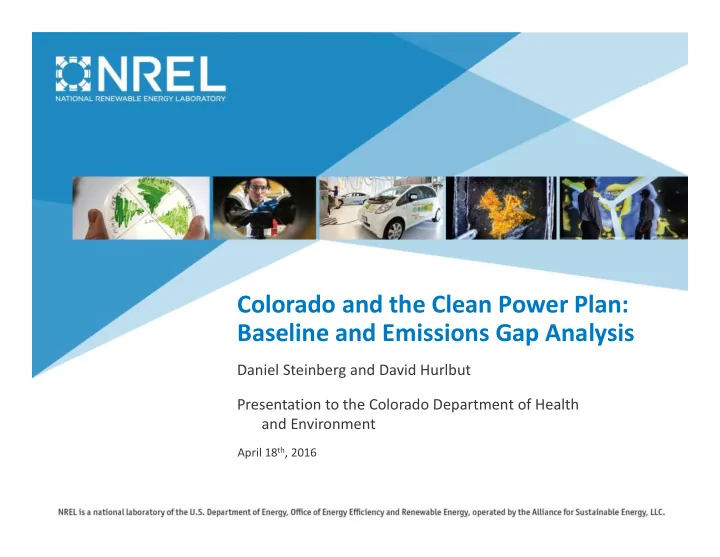

Colorado and the Clean Power Plan: Baseline and Emissions Gap Analysis Daniel Steinberg and David Hurlbut Presentation to the Colorado Department of Health and Environment April 18 th , 2016
Outline • Analysis Objectives • General Observations • Colorado and the CPP • Emission Gap Analysis • Considering “Leakage” – Analysis of New vs. Existing NGCCs 2
Objectives of Project and Analysis • Create a database/catalogue of generation units in Colorado from publicly available sources o Existing, under construction, and planned units o Capacity, generation, emissions, prime mover, fuel type, online year, retirement year, etc. • Create a common baseline of Colorado’s carbon emissions and emissions rate o Quantify the gap between existing emissions and emissions rate and the CPP targets 3
Momentum Towards Lower CO 2 Emissions • Since 2012 (the benchmark for calculating emission reduction targets), the amount of coal used in Colorado’s generation fuel mix has fallen while the use of combined cycle natural gas and renewables has increased, resulting in emissions reductions 1 • The combination of planned retirements/conversion of existing coal ‐ steam units and renewable energy projects that are newly completed, under construction, or in advanced planning will likely lead to additional emissions reductions over the next three years • Electricity consumption has slowed considerably, indicating greater energy efficiency in Colorado’s economy; if energy efficiency continues to improve emissions will be further 1 Note that these reductions only include changes in combustion emissions and do not consider emissions upstream of combustion such as leakage of methane from natural gas infrastructure 4
Colorado and the Clean Power Plan 5
Colorado and the Clean Power Plan Mass Targets Blended Rate Targets 28% Reduction 40% Reduction Light green indicates the interim target and dark green shows the final target 6
Colorado Generation Mix Data Source: EIA; PV capacity represents utility ‐ scale PV and does not include distributed systems 7
CO Power Sector Emissions Data Source: EIA 8
Changes to the Colorado System since 2012 • Decreased generation from retired coal units: Cherokee 1 & 3, Arapahoe 3 & 4 • New NGCC capacity and increased generation: Cherokee 5, 6, & 7 • New RE capacity and increased generation: o Wind: Colorado Highlands, Limon, Spring Canyon, Carousel, and Golden West Power Partners o PV: Hooper Solar + a number of small systems <2MW 2012 2015 Change Coal (TWh) 34.5 31.5 (3.0) NGCC (TWh) 8.8 9.9 1.1 RE (TWh) 7.6 9.2* 1.6* * A significant amount of wind and solar capacity came online late in 2015. Accounting for a full year of operation of those facilities would increase the change in RE to ~3.7 TWh. Sources: EIA ‐ 860, EIA ‐ 923, SNL, Velocity Suite 9
Planned Changes to the Existing System through 2017 • Further decreases in generation from coal units: o Retirement of Valmont 5; Martin Drake 5 o Conversion of Cherokee 4 • New RE capacity and increased generation o Wind: Trishe Wind, Wray Wind o PV: Comanche PV, Lincoln Alamosa County Generator Type 2016 ‐ 2017 Coal (TWh) (3.1) NGCC (TWh) ? RE (TWh) 1.0 * * Only includes projects that are under construction or permitted Sources: EIA ‐ 860, EIA ‐ 923, SNL, Velocity Suite 10
Energy Efficiency Energy Efficiency Resource Standard (EERS) Targets: • Xcel: 400 GWh annual incremental savings through 2020 • Black Hills: ~20 GWh annual incremental savings through 2018 Residential and Commercial Electricity Consumption Residential Electricity Commercial Electricity Consumption per Capita Consumption per $ GDP Sources: EIA ‐ 860, EIA ‐ 923, SNL, Velocity Suite 11
Electricity Consumption Pre ‐ recession growth: Post ‐ recession growth: ~2.2% per year ~0.6% per year 12
Emissions Gap Analysis 13
General Approach • Calculate the total covered emissions and blended emissions rate for historical years: 2012 ‐ 2014 • Estimate emissions and blended emissions rate accounting for recent and planned retirements and additions: All Operational – accounts for recent retirements, currently online 1. renewable and NGCC capacity All Operational and Planned Retirements – accounts for the 2. retirement of Valmont, Cherokee 3, and Drake 5, and conversion of Cherokee 4 All Operation, Planned Retirements, and Under Construction RE 3. All Operational, All Operation, Planned Retirements, Under 4. Construction RE, and Permitted RE 14
Key Assumptions and Limitations for this Analysis • Historical generation from retired coal capacity is assumed to be replaced with generation from an efficient NGCC unit • New renewable generation is assumed to be additional to all current generation (no generation is offset) o Implicit assumption is that new RE covers load growth • Energy efficiency is not considered • Based on historical generation and expected new generation – not optimized dispatch 15
Colorado’s Emissions Gap 16
Colorado’s Emissions Gap “All Operational” includes all capacity online as of the end of 2015, and that capacity that came online in 2015 was operating for a full year. 17
Colorado’s Emissions Gap 18
Colorado’s Emissions Gap 19
Colorado’s Emissions Gap 20
Conclusions • As a result of recent and forthcoming retirements of fossil ‐ steam units and additions of both renewable and natural gas combined cycle units, CO’s power sector emissions are on a downward trend • These changes put Colorado on a path towards compliance, yet additional measures may be needed to achieve compliance with the final targets • Capacity expansion modeling could be used to identify alternative pathways towards compliance and their associated costs and benefits 21
Thank you!
Recommend
More recommend